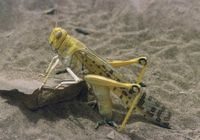
Photo from wikipedia
Penetration of the cuticle, the first physical barrier to pathogenic fungi, is the prerequisite for fungal infection of insects. In the entomopathogenic fungus Metarhizium robertsii, we found that the Fus3–mitogen-activated… Click to show full abstract
Penetration of the cuticle, the first physical barrier to pathogenic fungi, is the prerequisite for fungal infection of insects. In the entomopathogenic fungus Metarhizium robertsii, we found that the Fus3–mitogen-activated protein kinase (MAPK) and the transcription factor regulator of nutrient selection 1 (RNS1) constitute a novel cascade that controls cuticle penetration by regulating degradation of cuticular lipids, proteins, and chitin to obtain nutrients for hyphal growth and entry into the insect hemocoel. ABSTRACT The entomopathogenic fungus Metarhizium robertsii can switch among parasitic, saprophytic, and symbiotic lifestyles in response to changing nutritional conditions, which is attributed to its extremely versatile metabolism. Here, we found that the Fus3–mitogen-activated protein kinase (MAPK) and the transcription factor regulator of nutrient selection 1 (RNS1) constitute a novel fungal cascade that regulates the degradation of insect cuticular lipids, proteins, and chitin to obtain nutrients for hyphal growth and enter the insect hemocoel for subsequent colonization. On the insect cuticle, Fus3-MAPK physically contacts and phosphorylates RNS1, which facilitates the entry of RNS1 into nuclei. The phosphorylated RNS1 binds to the DNA motif BM2 (ACCAGAC) in its own promoter to self-induce expression, which then activates the expression of genes for degrading cuticular proteins, chitin, and lipids. We further found that the Fus3-MAPK/RNS1 cascade also activates genes for utilizing complex and less-favored nitrogen and carbon sources (casein, colloid chitin, and hydrocarbons) that were not derived from insects, which is repressed by favored organic carbon and nitrogen nutrients, including glucose and glutamine. In conclusion, we discovered a novel regulatory cascade that controls fungal nitrogen and carbon metabolism and is implicated in the entomopathogenicity of M. robertsii. IMPORTANCE Penetration of the cuticle, the first physical barrier to pathogenic fungi, is the prerequisite for fungal infection of insects. In the entomopathogenic fungus Metarhizium robertsii, we found that the Fus3–mitogen-activated protein kinase (MAPK) and the transcription factor regulator of nutrient selection 1 (RNS1) constitute a novel cascade that controls cuticle penetration by regulating degradation of cuticular lipids, proteins, and chitin to obtain nutrients for hyphal growth and entry into the insect hemocoel. In addition, during saprophytic growth, the Fus3-MAPK/RNS1 cascade also activates utilization of complex and less-favored carbon and nitrogen sources that are not derived from insects. The homologs of Fus3-MAPK and RNS1 are widely found in ascomycete filamentous fungi, including saprophytes and pathogens with diverse hosts, suggesting that the regulation of utilization of nitrogen and carbon sources by the Fus3-MAPK/RNS1 cascade could be widespread. Our work provides significant insights into regulation of carbon and nitrogen metabolism in fungi and fungal pathogenesis in insects.
Journal Title: mSystems
Year Published: 2021
Link to full text (if available)
Share on Social Media: Sign Up to like & get
recommendations!